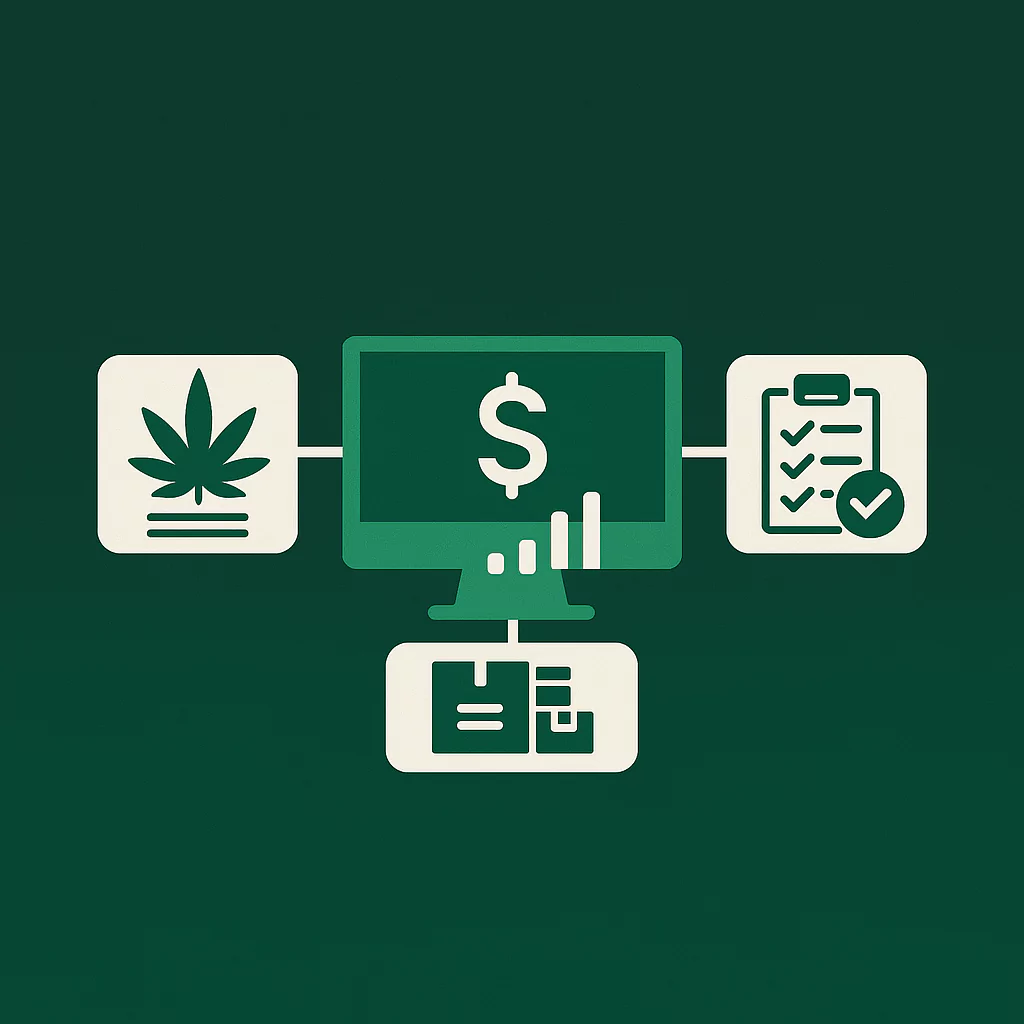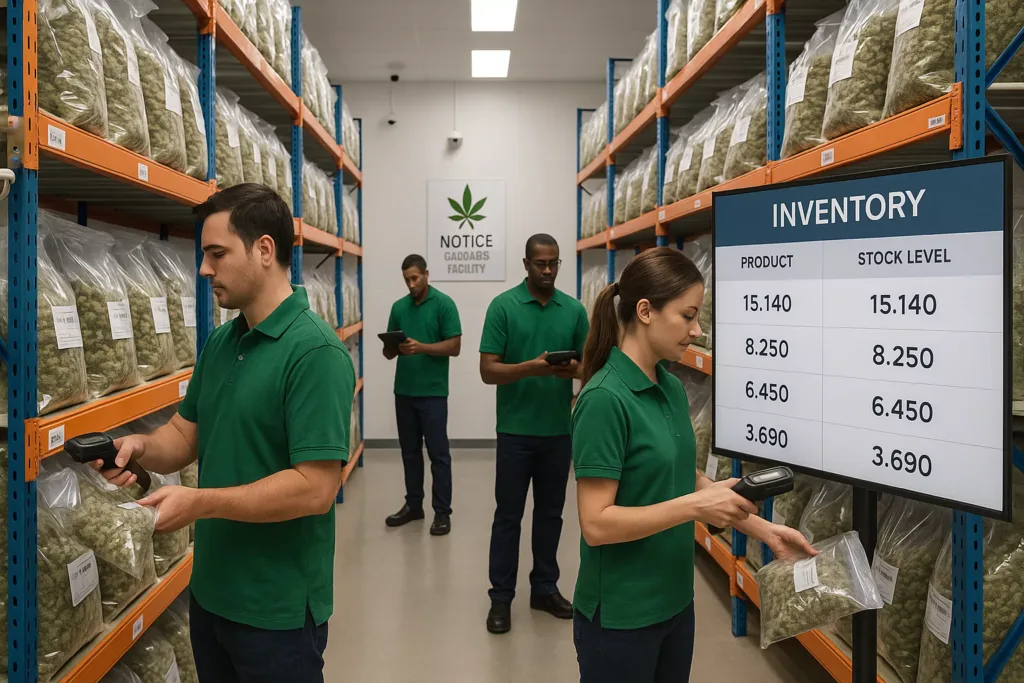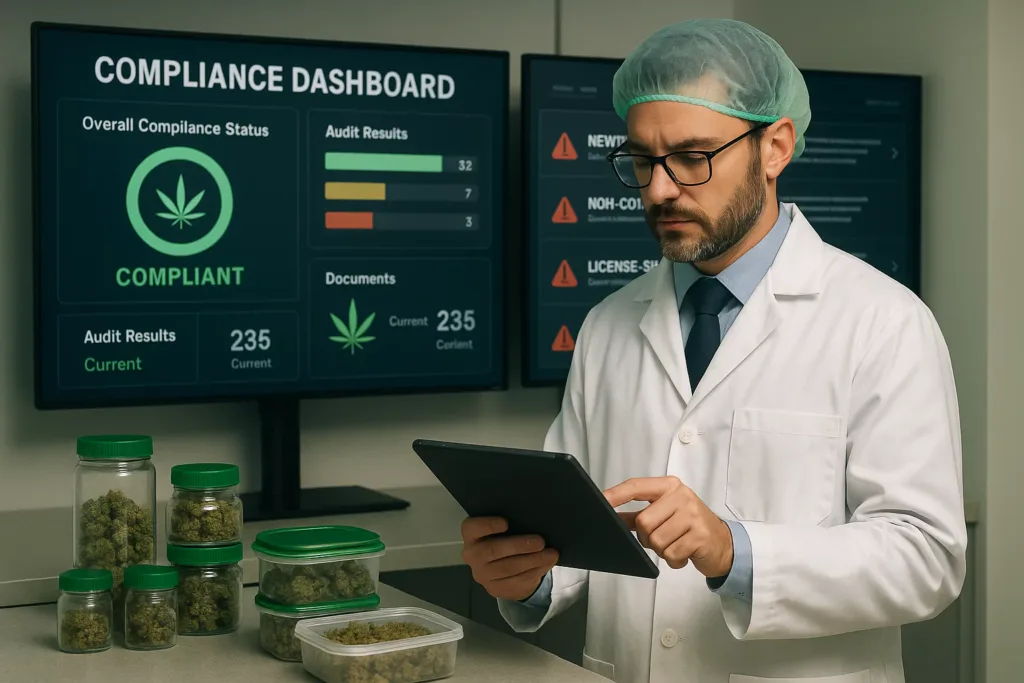
Simplifying Cannabis Accounting with Integrated ERP Solutions
The cannabis industry faces unique accounting challenges that traditional business software often fails to address effectively. Cannabis ERP solutions are specifically designed to streamline accounting processes while simultaneously managing the complex regulatory environment this industry operates within. For warehouse and supply chain professionals, implementing a comprehensive cannabis ERP system creates a foundation for accurate financial tracking, improved inventory management, and seamless compliance reporting. By integrating these critical functions into a single platform, businesses can eliminate data silos and reduce the manual workarounds that often lead to errors and inefficiencies.
Cannabis accounting requires meticulous attention to detail due to specific tax regulations like IRC 280E, which prohibits standard business deductions for cannabis operations. An integrated ERP solution helps track cost of goods sold (COGS) separately from non-deductible expenses, ensuring proper tax calculations and documentation. This level of granular financial tracking is nearly impossible with disconnected systems or generic accounting software. Furthermore, cannabis ERP platforms automate routine accounting tasks such as invoice generation, payment processing, and financial reporting, freeing staff to focus on higher-value activities while maintaining precise records for audit readiness.
The financial benefits of implementing a cannabis ERP extend beyond basic accounting functions. These systems provide real-time visibility into profit margins across different products and operational areas, allowing managers to identify underperforming segments and optimize resource allocation. By automating complex calculations and reconciliation processes, cannabis ERPs significantly reduce the time finance teams spend on data entry and report generation. This automation also minimizes human error, which is particularly valuable in an industry where financial discrepancies can trigger regulatory scrutiny and potentially costly investigations.
For multi-location cannabis operations, centralized accounting through an ERP system enables standardized financial processes across all facilities while maintaining location-specific reporting capabilities. This balance between consistency and flexibility supports both operational efficiency and compliance requirements. Additionally, cannabis ERPs typically include built-in audit trails that document every financial transaction and system change, creating transparent accountability that satisfies both internal controls and external regulatory requirements. This comprehensive approach to cannabis accounting transforms what was once a burdensome necessity into a strategic business advantage.
Real-Time Inventory Management in Cannabis Operations

In the cannabis industry, inventory management goes far beyond simple stock counts—it requires seed-to-sale tracking that documents every gram of product throughout its lifecycle. Cannabis ERP systems excel at this level of granular inventory control by implementing barcode or RFID tracking systems that monitor products from cultivation through processing, packaging, and final sale. This unbroken chain of custody not only satisfies regulatory requirements but also provides warehouse managers with unprecedented visibility into inventory movements and status. Real-time updates eliminate the delays associated with manual inventory counts, allowing for more responsive decision-making and resource allocation.
Cannabis businesses must maintain precise inventory records to demonstrate compliance with state regulations and avoid potentially devastating penalties. An integrated ERP solution automatically reconciles physical inventory counts with system records, flagging discrepancies that require immediate attention. This continuous verification process helps prevent inventory shrinkage while maintaining the accurate records required during regulatory inspections. The system can also enforce proper handling procedures by requiring specific documentation at critical transfer points, ensuring that all inventory movements follow approved protocols and maintain regulatory compliance.
Effective demand forecasting represents another significant advantage of cannabis ERP inventory management. By analyzing historical sales data, seasonal trends, and market developments, these systems help warehouse managers optimize stock levels to prevent both stockouts and excess inventory. This balanced approach is particularly important in the cannabis industry, where products have limited shelf life and carrying costs include specialized storage requirements. Cannabis ERPs can also integrate with point-of-sale systems to provide real-time sales data that triggers automated reordering when inventory reaches predetermined thresholds, maintaining optimal stock levels without manual intervention.
For cannabis processors and manufacturers, ERP systems enhance production planning by linking inventory levels with manufacturing schedules. This integration ensures that raw materials are available when needed while minimizing storage costs and reducing waste. The system can track batch-specific information, including cultivation details, testing results, and expiration dates, maintaining complete product traceability. This level of detail not only supports compliance requirements but also facilitates targeted recalls if quality issues arise, limiting potential liability and protecting both consumers and the business’s reputation in this highly scrutinized industry.
Ensuring Regulatory Compliance Through Cannabis ERP

Regulatory compliance represents one of the most significant challenges facing cannabis businesses, with requirements varying by state and constantly evolving as the industry matures. Cannabis ERP systems address this challenge by incorporating compliance management tools designed specifically for this regulated environment. These systems automatically apply the appropriate rules based on business location and license type, updating processes and documentation requirements as regulations change. This automated approach significantly reduces the risk of non-compliance while decreasing the administrative burden on staff who would otherwise need to manually track regulatory updates and implement changes across multiple systems.
State track-and-trace systems like METRC and BioTrack present particular challenges for cannabis operations, requiring detailed reporting on inventory movements and transactions. An integrated cannabis ERP can automate these reporting requirements, extracting the necessary data from normal business operations and formatting it to meet regulatory specifications. This seamless reporting eliminates duplicate data entry and reduces the risk of reporting errors that could trigger regulatory investigations. Some advanced cannabis ERPs even offer direct API connections to state systems, automatically transferring required information without manual intervention, further streamlining compliance processes.
Testing management represents another critical compliance area where cannabis ERPs deliver significant value. These systems can track sample submission, monitor testing status, and link certificate of analysis (COA) documentation directly to specific inventory batches. When test results indicate non-compliance with quality or potency standards, the ERP can automatically quarantine affected inventory, preventing its release into the supply chain. This systematic approach to testing management ensures that only compliant products reach consumers while maintaining the documentation required to demonstrate regulatory adherence during inspections or audits.
The financial aspects of cannabis compliance are equally important, with businesses facing specialized tax rules and reporting requirements. Cannabis ERPs include tax calculation engines that automatically apply the appropriate rates for different transaction types, including the complex rules surrounding cannabis excise taxes. The system maintains comprehensive audit trails of all financial transactions, generating the reports required for tax filings and regulatory submissions. This automated documentation creates a defensible compliance position, demonstrating good-faith efforts to follow regulations even in areas where requirements may be ambiguous or subject to interpretation.
Centralizing Data for Better Decision-Making

Data fragmentation presents a significant challenge for cannabis businesses using separate systems for accounting, inventory, and compliance management. This disconnected approach forces managers to manually compile information from multiple sources, often leading to delayed decisions based on outdated or incomplete data. Cannabis ERP systems solve this problem by creating a central repository for all operational data, enabling real-time analysis and reporting across functional areas. This unified data model eliminates discrepancies between systems and provides a single source of truth for all business activities, supporting more confident and timely decision-making throughout the organization.
Effective reporting capabilities represent a core benefit of centralized data management in cannabis ERPs. These systems typically include customizable dashboards that present key performance indicators (KPIs) relevant to each user’s role, from inventory metrics for warehouse managers to financial summaries for executives. Users can drill down from high-level summaries to transaction-level details, investigating variances and identifying root causes without switching between applications. This seamless access to information empowers employees at all levels to make data-driven decisions aligned with organizational goals and compliance requirements, improving overall operational efficiency.
Advanced analytics capabilities within cannabis ERPs transform raw data into actionable business intelligence. These tools can identify patterns and relationships that might not be apparent through standard reporting, revealing optimization opportunities across the operation. For example, the system might correlate inventory turnover rates with specific suppliers or cultivation methods, highlighting approaches that maximize efficiency and profitability. Similarly, analytics can identify compliance risk factors by analyzing historical audit results and regulatory interactions, allowing proactive measures to address potential issues before they trigger regulatory action or operational disruptions.
The value of centralized data extends beyond internal operations to relationships with external stakeholders. Cannabis ERPs can generate comprehensive reports for investors, demonstrating business performance and compliance status with credible, system-generated documentation. Similarly, the system can provide regulatory agencies with required information in standardized formats, streamlining inspections and audits. For supply chain partners, centralized data enables more accurate forecasting and collaborative planning, strengthening relationships throughout the value chain. This improved external communication represents a significant competitive advantage in an industry where trust and reliability are paramount.
Key Considerations When Selecting a Cannabis ERP System
When evaluating cannabis ERP solutions, industry-specific functionality should be a primary consideration. Generic ERP systems often lack the specialized features needed for cannabis operations, such as seed-to-sale tracking, compliance reporting, and cannabis-specific tax calculations. Warehouse and supply chain leaders should prioritize platforms designed specifically for the cannabis industry or those with robust cannabis modules built on proven ERP foundations. During vendor evaluations, request detailed demonstrations of industry-specific features and ask about the provider’s experience implementing their solution in similar cannabis operations. This focus on industry alignment ensures the selected system will address the unique challenges of cannabis supply chain management without requiring extensive customization.
Integration capabilities represent another critical evaluation factor, as most cannabis businesses utilize specialized tools that must connect with the core ERP system. Key integration points typically include state track-and-trace systems, e-commerce platforms, point-of-sale systems, and cultivation management software. When assessing potential ERP solutions, inquire about available APIs, pre-built connectors, and the vendor’s experience with similar integrations. Ask about the level of data synchronization between systems—real-time bidirectional integration provides significant advantages over periodic batch updates, particularly for inventory and compliance functions where timing is critical. The most effective cannabis ERP implementations create a seamless ecosystem of connected applications rather than replacing existing specialized tools.
Scalability considerations should guide ERP selection, particularly for growing cannabis operations. The chosen system must accommodate increasing transaction volumes, additional users, and new business locations without performance degradation. Cloud-based cannabis ERPs typically offer greater scalability than on-premises solutions, with the ability to add resources as needs evolve. Beyond technical scalability, evaluate the system’s functional scalability—can it support additional business processes as operations mature? For example, a system selected primarily for inventory and compliance management should still offer robust manufacturing and distribution modules that can be implemented later as operations expand. This growth-oriented approach prevents the need for system replacement as the business evolves.
Implementation approach and vendor support represent final critical factors in cannabis ERP selection. Because these systems touch every aspect of operations, implementation requires careful planning and change management. Evaluate potential vendors based on their implementation methodology, industry expertise, and support resources. Request references from similar cannabis operations and inquire about their implementation experience and ongoing support quality. The most successful implementations typically involve phased approaches that prioritize critical functions while allowing operations to continue during the transition. This methodical implementation strategy, combined with comprehensive training and responsive vendor support, maximizes the return on investment in cannabis ERP technology while minimizing operational disruption.
Conclusion
Implementing a comprehensive cannabis ERP system represents a strategic investment that transforms how cannabis businesses manage accounting, inventory, and compliance processes. By integrating these critical functions into a unified platform, companies gain efficiency, accuracy, and visibility that disconnected systems simply cannot provide. The real-time data and automated workflows within cannabis ERP solutions eliminate redundant processes, reduce manual errors, and free staff to focus on value-adding activities rather than administrative tasks. For warehouse and supply chain professionals in the cannabis industry, these improvements translate directly to operational excellence and competitive advantage in an increasingly sophisticated market.
The compliance benefits of cannabis ERP systems cannot be overstated in an industry where regulatory adherence directly impacts business viability. By automating compliance processes and documentation, these systems reduce risk while simultaneously decreasing the administrative burden associated with regulatory requirements. This balanced approach to cannabis compliance supports both operational efficiency and legal protection, allowing businesses to operate confidently even as regulations continue to evolve. For decision-makers evaluating technology investments, cannabis ERP solutions offer a compelling combination of risk reduction and operational improvement that few other systems can match.
As the cannabis industry continues to mature and consolidate, the operational sophistication enabled by comprehensive ERP systems will likely become a standard requirement rather than a competitive advantage. Forward-thinking organizations are implementing these solutions now to establish efficient processes and gain experience with integrated operations before market pressures make such changes mandatory. By carefully selecting and implementing a cannabis ERP system aligned with their specific needs, warehouse and supply chain professionals can position their organizations for sustainable growth and compliance in this dynamic industry landscape.
Frequently Asked Questions (FAQ)
Q1: What are the main benefits of using a cannabis ERP for accounting and compliance?
Using a cannabis ERP for accounting and compliance offers streamlined financial management, real-time inventory tracking, and automated compliance reporting. By centralizing critical data in one system, cannabis businesses can reduce manual errors, maintain accurate records for audits, and quickly adapt to regulatory changes. This integrated approach simplifies workflows, ensures traceability across the supply chain, and supports secure, transparent operations. Warehouse and supply chain professionals benefit from improved visibility, efficiency, and the ability to make data-driven decisions while meeting industry requirements. Additionally, cannabis ERPs often include specialized tax calculation features that address the unique financial regulations facing cannabis businesses, such as 280E limitations and state-specific excise taxes.
Q2: How does a cannabis ERP system differ from standard accounting software?
Cannabis ERP systems differ from standard accounting software by integrating seed-to-sale tracking, regulatory compliance features, and industry-specific tax handling in addition to traditional accounting functions. While standard accounting software focuses primarily on financial transactions, cannabis ERPs provide complete operational visibility by connecting inventory, manufacturing, sales, and compliance with financial management. These systems include specialized features for tracking regulatory requirements, managing complex cannabis tax scenarios, and maintaining the detailed audit trails required in the cannabis industry. Cannabis ERPs also typically offer direct integration with state track-and-trace systems, specialized reporting for cannabis regulatory agencies, and workflows designed specifically for the unique operational requirements of cannabis businesses.
Q3: What implementation challenges should cannabis businesses anticipate with ERP systems?
When implementing cannabis ERP systems, businesses should anticipate challenges including data migration from legacy systems, staff training requirements, and potential operational disruptions during transition periods. Cannabis operations often have complex existing processes that must be carefully mapped to new system workflows, requiring significant configuration and occasionally customization. Integration with state track-and-trace systems presents particular challenges due to varying requirements across jurisdictions and frequent regulatory changes. Additionally, cannabis businesses should plan for comprehensive change management efforts, as ERP implementation typically affects most operational areas simultaneously. Successful implementations require executive sponsorship, clear project governance, adequate resource allocation, and realistic timeline expectations based on operational complexity.
Q4: How can cannabis ERPs help with inventory reconciliation and loss prevention?
Cannabis ERPs help with inventory reconciliation and loss prevention through continuous tracking, automated variance identification, and detailed audit trails for all inventory movements. These systems implement barcode or RFID scanning at key transfer points, ensuring accurate recording of product movements and reducing manual entry errors. Real-time inventory visibility allows managers to quickly identify discrepancies between physical counts and system records, enabling prompt investigation of potential losses. Cannabis ERPs can also enforce inventory handling procedures by requiring specific documentation and approval workflows for sensitive processes like waste disposal or sample removal. The system’s detailed transaction history creates accountability by recording which users performed specific inventory actions, deterring internal theft while supporting thorough investigations when discrepancies occur.
Q5: What are the most important integration points for cannabis ERP systems?
The most important integration points for cannabis ERP systems include state track-and-trace platforms (like METRC or BioTrack), point-of-sale systems, e-commerce platforms, and cultivation management software. These connections ensure data flows seamlessly between specialized operational systems and the core ERP platform, maintaining data consistency while eliminating duplicate entry. Additional valuable integration points include banking and payment processing systems, CRM platforms for customer management, laboratory information management systems (LIMS) for testing results, and transportation management systems for distribution operations. The most effective cannabis ERP implementations create an interconnected ecosystem where data moves automatically between systems, maintaining both operational efficiency and compliance documentation requirements across the entire supply chain.



